What is Simmered Kiriboshi Daikon?
Kiriboshi Daikon no Nimono (切り干し大根の煮物) is a side dish made with rehydrated strips of daikon radish simmered in a Japanese broth with carrots, shiitake mushrooms, and satsuma-age (fried fish cake) or aburaage (twice-fried tofu).
I would say the taste is usually a little sweet with a touch of dashi, so it goes well with any rice dishes. It’s one of the most popular side dishes at home in Japan.
Kiriboshi daikon itself is a type of dried daikon radish sliced into thin strips and may be labeled as “dried radish.”
In Western Japan, it is known as “sengiri daikon,” which translates to “julienned daikon.” The strips are typically 1-2mm thick. Prior to use, kiriboshi daikon should be washed and soaked lightly to rehydrate and soften it.
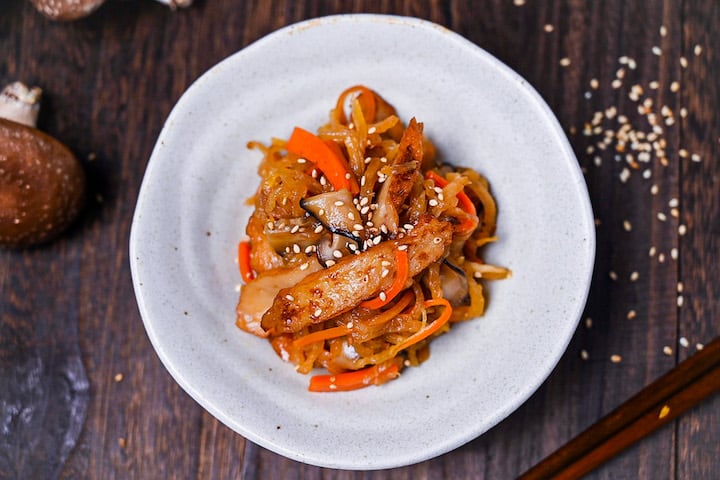
Ingredients & Substitution Ideas
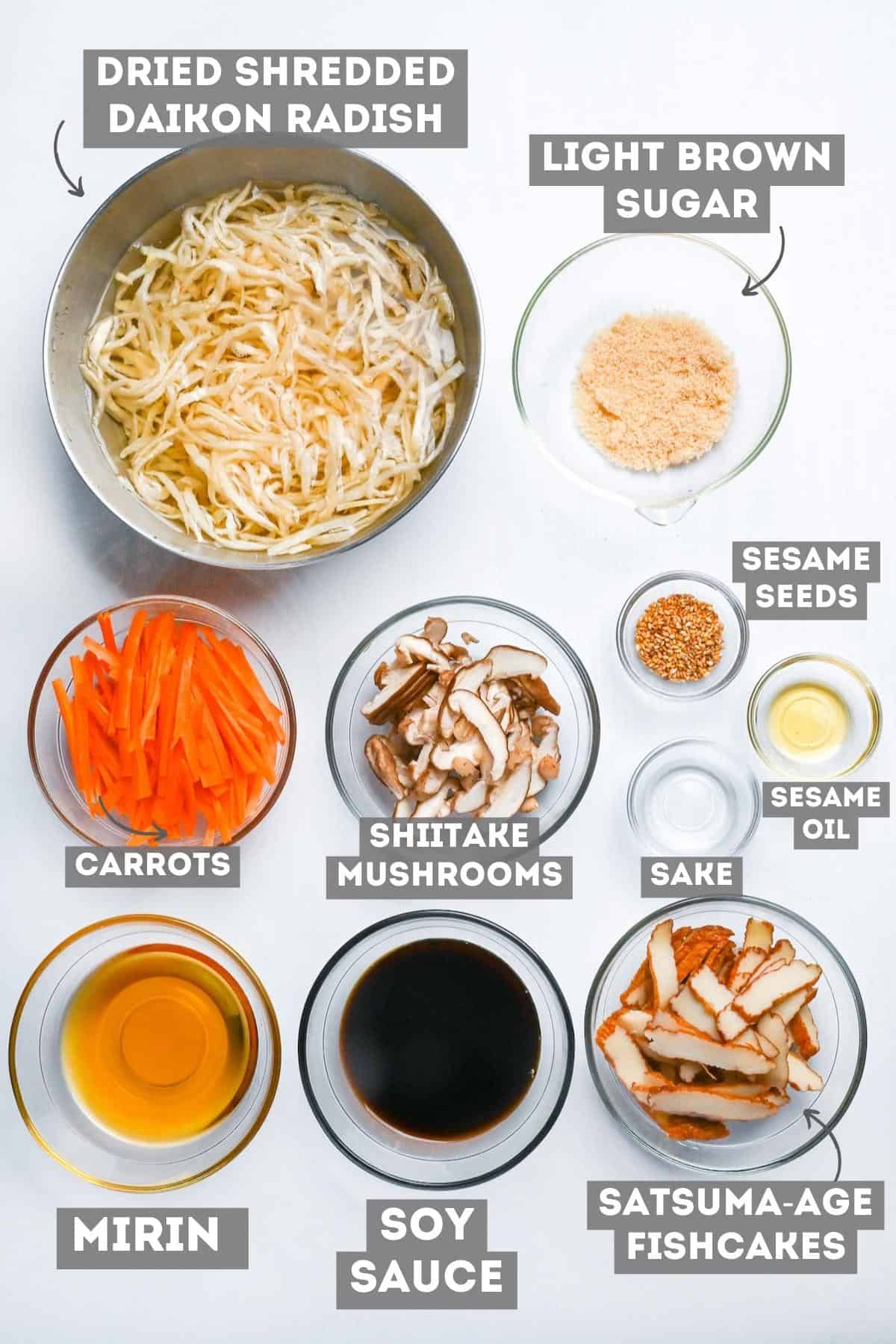
- Dried Shredded Daikon Radish (Kiriboshi Daikon): This is a crucial ingredient for the dish. I have to note that raw fresh radish is not a suitable substitute.
- Sesame Oil: I recommend Kadoya’s sesame oil to impart marinades a delicate flavor.
- Vegetables: I used carrots and shiitake mushrooms.
- Satsumaage Fishcake: This is a type of Japanese fried fishcake. If you can’t find it, fried tofu pouch (aburaae) is a recommended alternative.
- Soy Sauce: For a deeper dive into selecting the perfect soy sauce for Japanese dishes, refer to my comprehensive soy sauce guide.
- Mirin: When shopping for mirin, “hon mirin” (本みりん) is the gold standard for flavor.
- Sugar: While any standard sugar is acceptable, I prefer light brown cane sugar in many of my recipes.
- Sake: If sake is unavailable, white wine or dry sherry can be used as substitutes.
- White Sesame Seeds: These are optional but can be used as a garnish for added texture and aesthetics.
Switch the fishcake (satsuma-age) for deep-fried tofu pouches (aburaage) or even thinly sliced firm tofu to make this dish suitable for vegetarians and vegans!
Jump to Full Recipe Measurements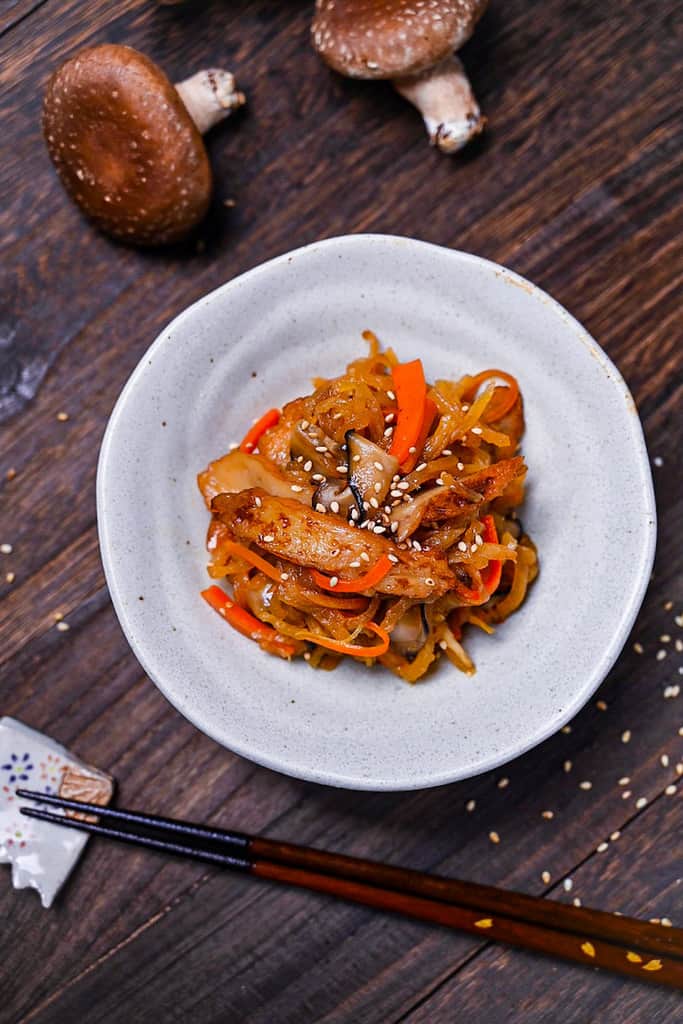
Visual Walkthrough & Tips
Here are my step-by-step instructions for how to make Kiriboshi Daikon at home. For ingredient quantities and simplified instructions, scroll down for the Printable Recipe Card below.
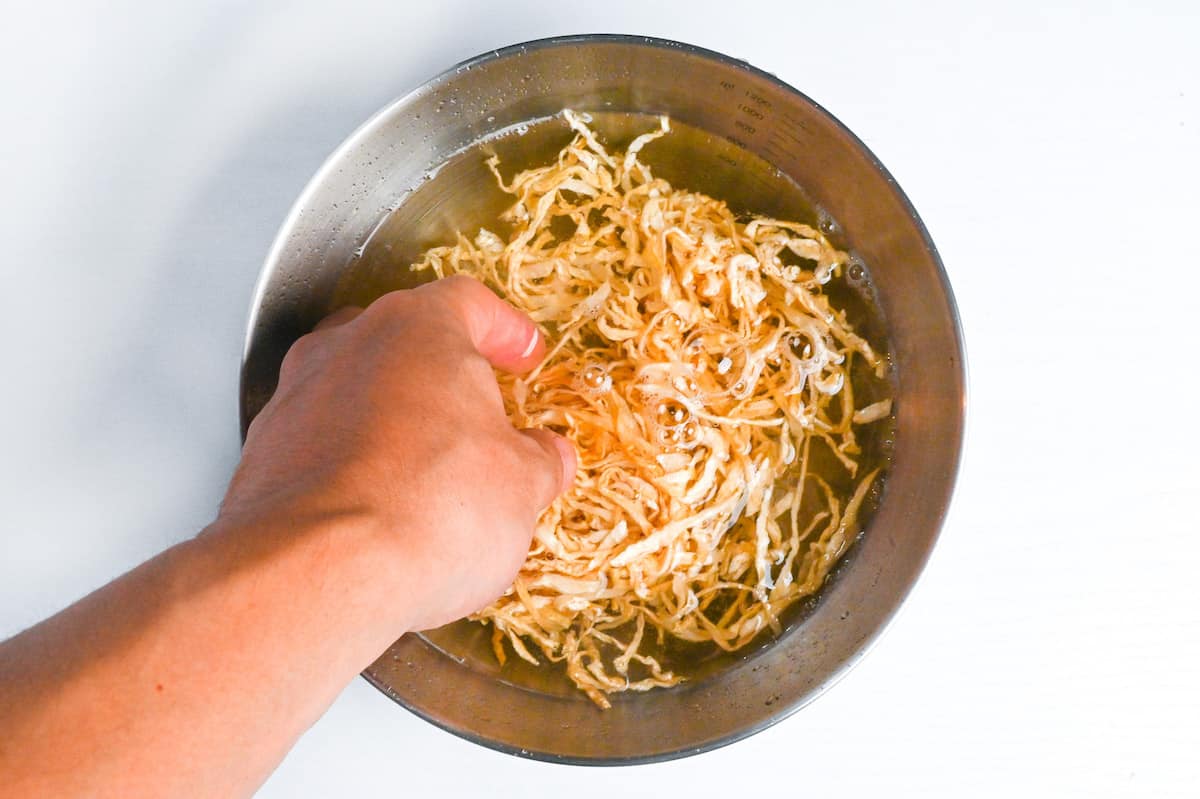
Place the kiriboshi daikon in a bowl of cold water and rub it gently to remove any dust or debris. Drain and repeat 3 times in total to ensure it’s properly cleaned.
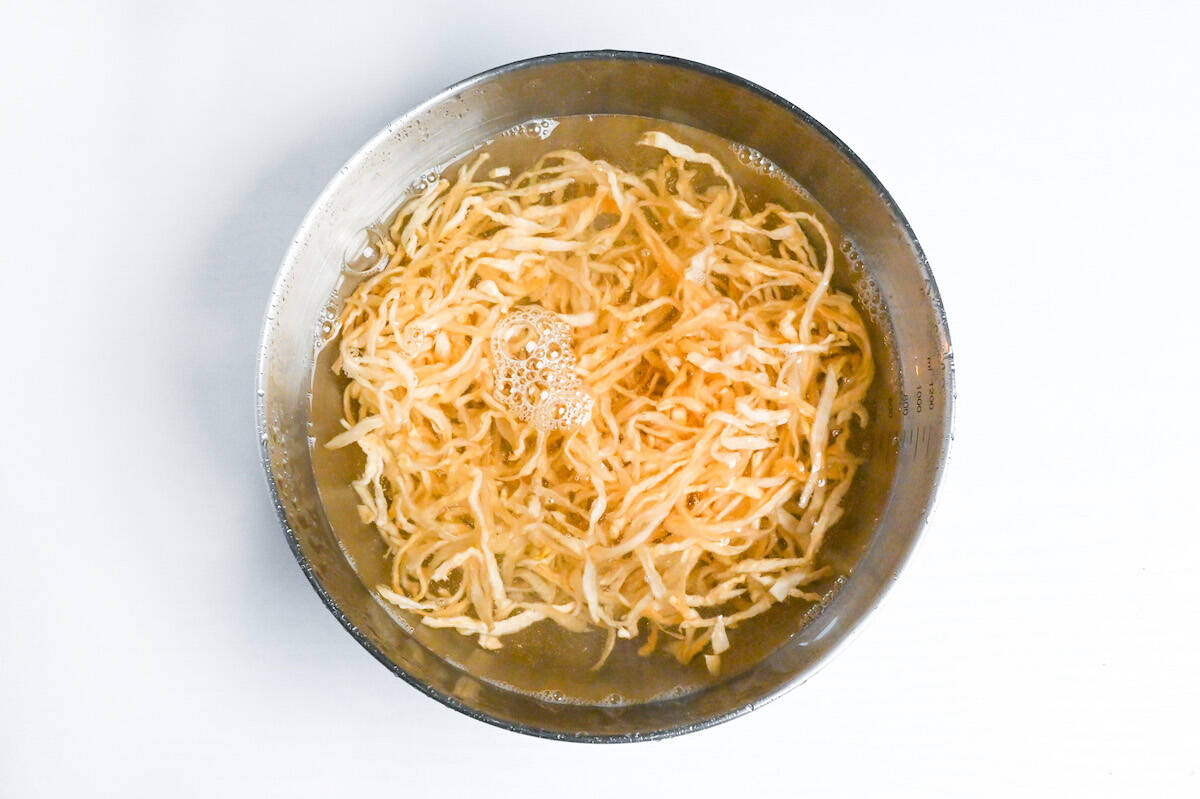
Once thoroughly washed, add fresh water and soak for 20 minutes to rehydrate.
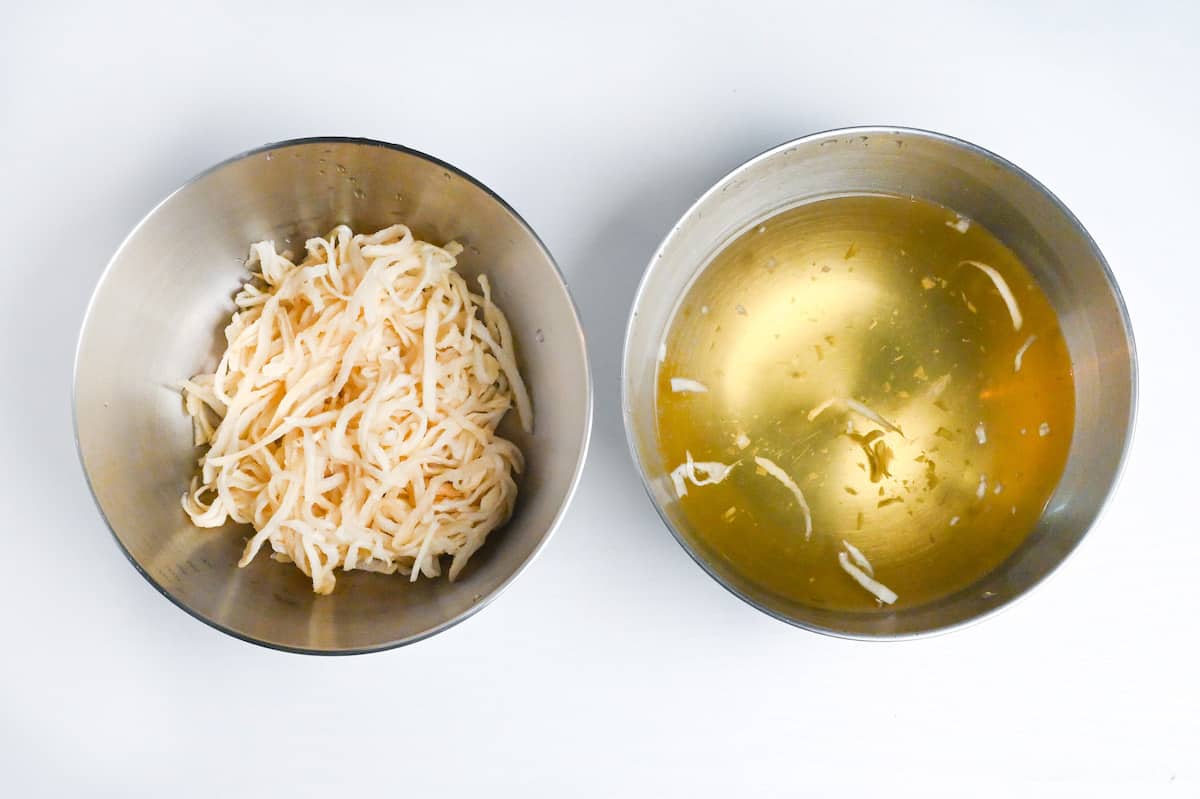
After 20 minutes, remove the kiriboshi daikon from the water and set aside for later.
The leftover liquid is a kiriboshi-daikon soup stock and is sometimes used as “vegetarian soup stock” at temples in Japan. It’s really a waste to throw it away. It’s packed with umami so there’s no reason not to use it!
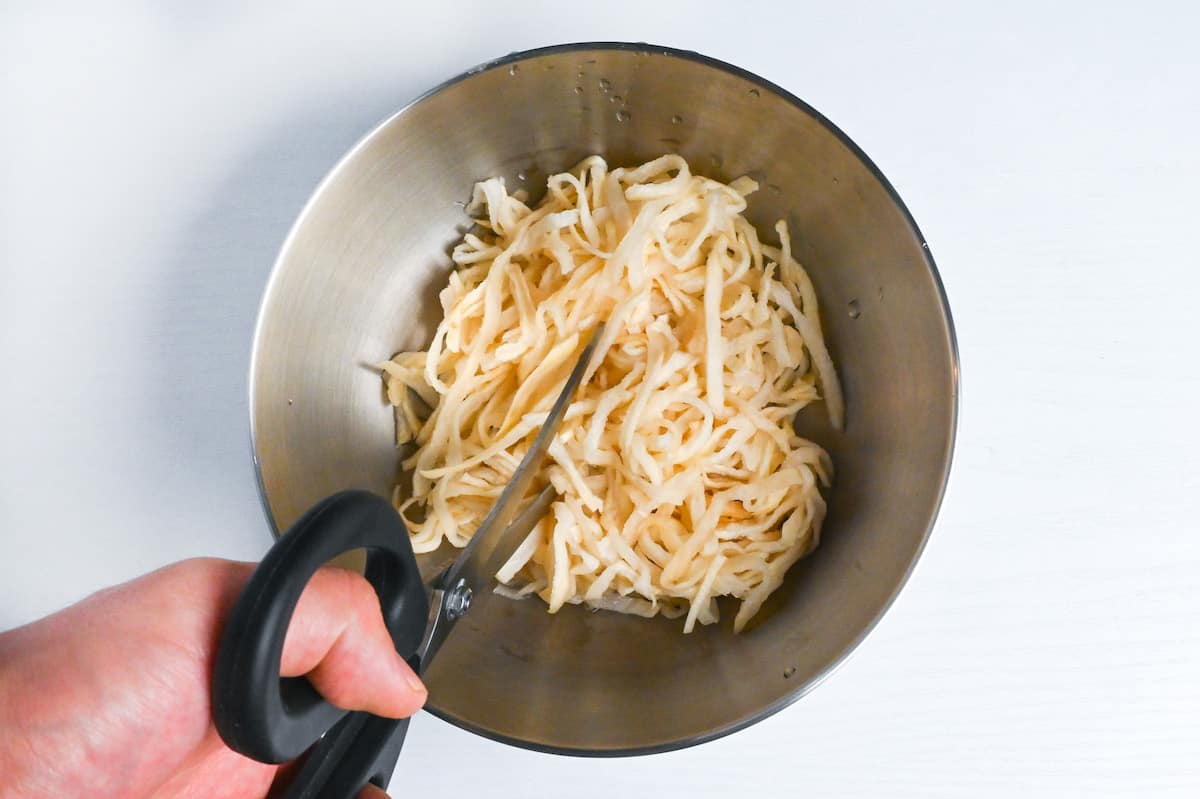
If the kiriboshi daikon pieces are too long, cut them into thirds using scissors. This will make it easier to eat.
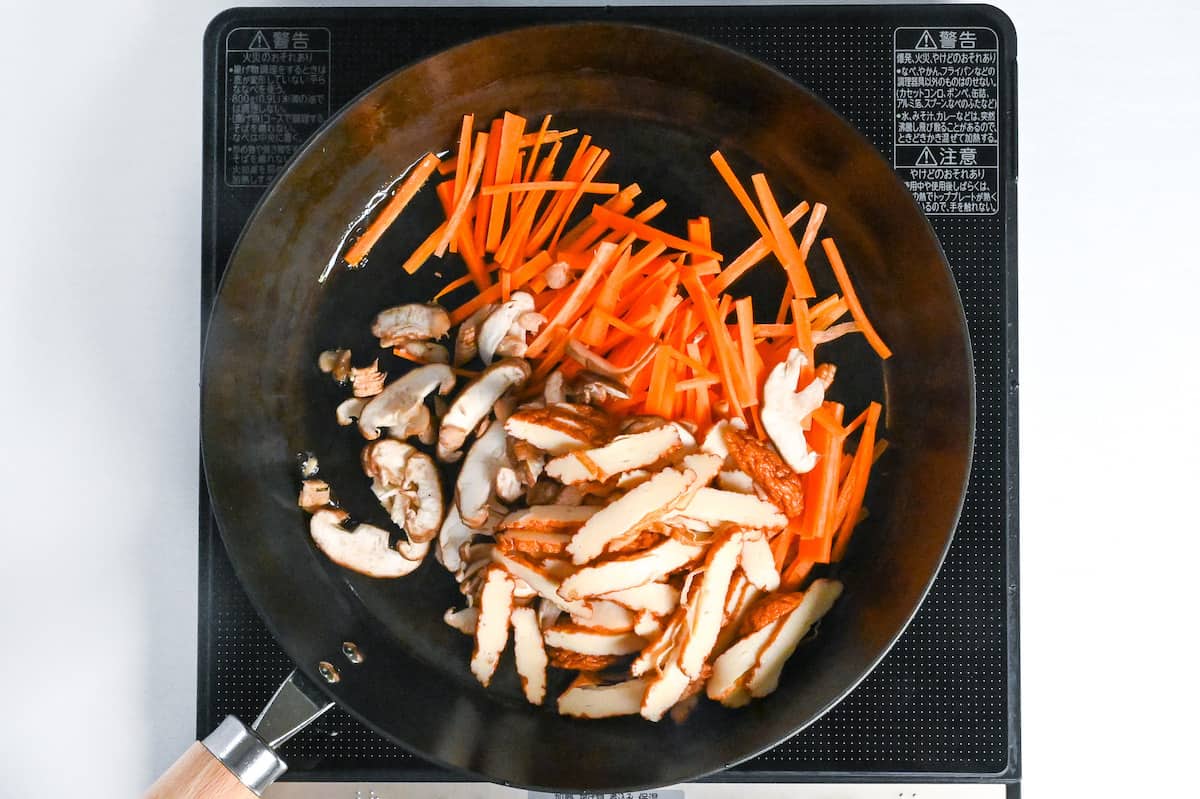
Heat a large pan on medium and add a drizzle of sesame oil. Once hot, add julienned carrots and thinly sliced shiitake mushrooms and satsuma-age (Japanese fishcakes). Stir fry for 2-3 minutes.
Frying the ingredients in oil first will improve the texture, and then simmering will give it a richer flavor.
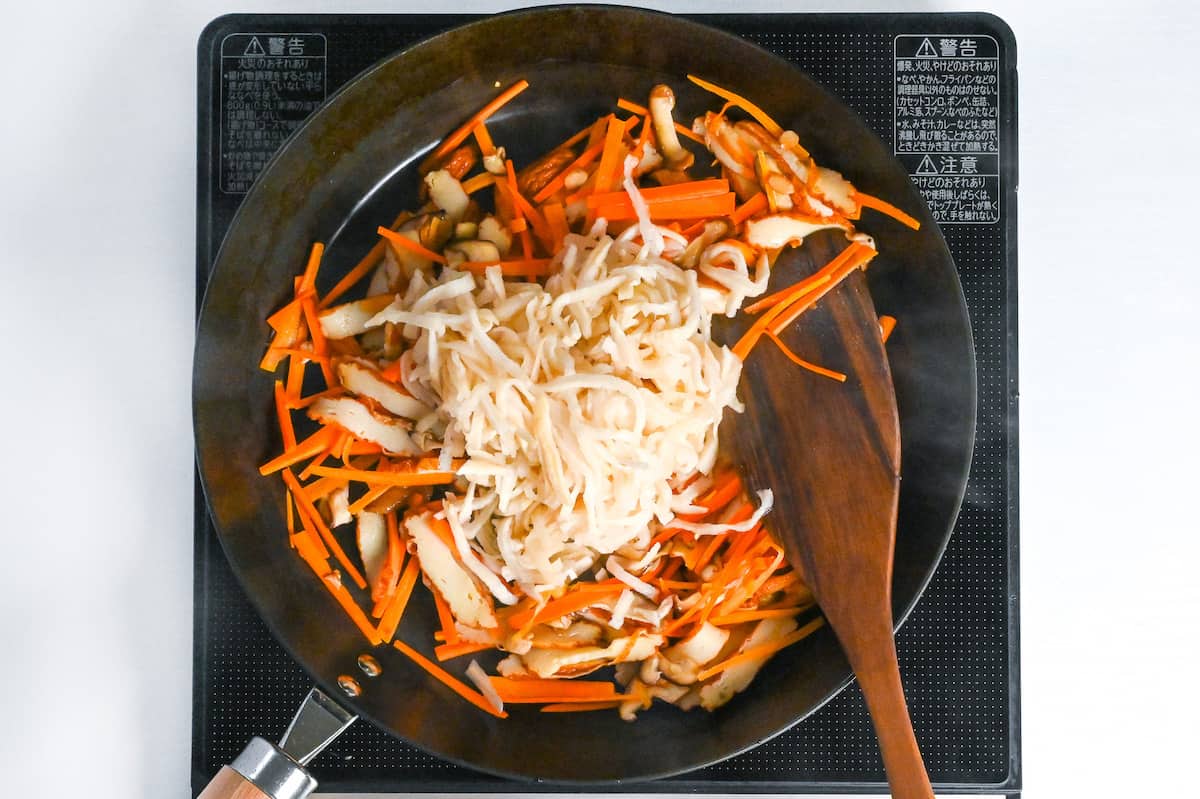
Add the kiriboshi daikon and stir fry for 1 minute.
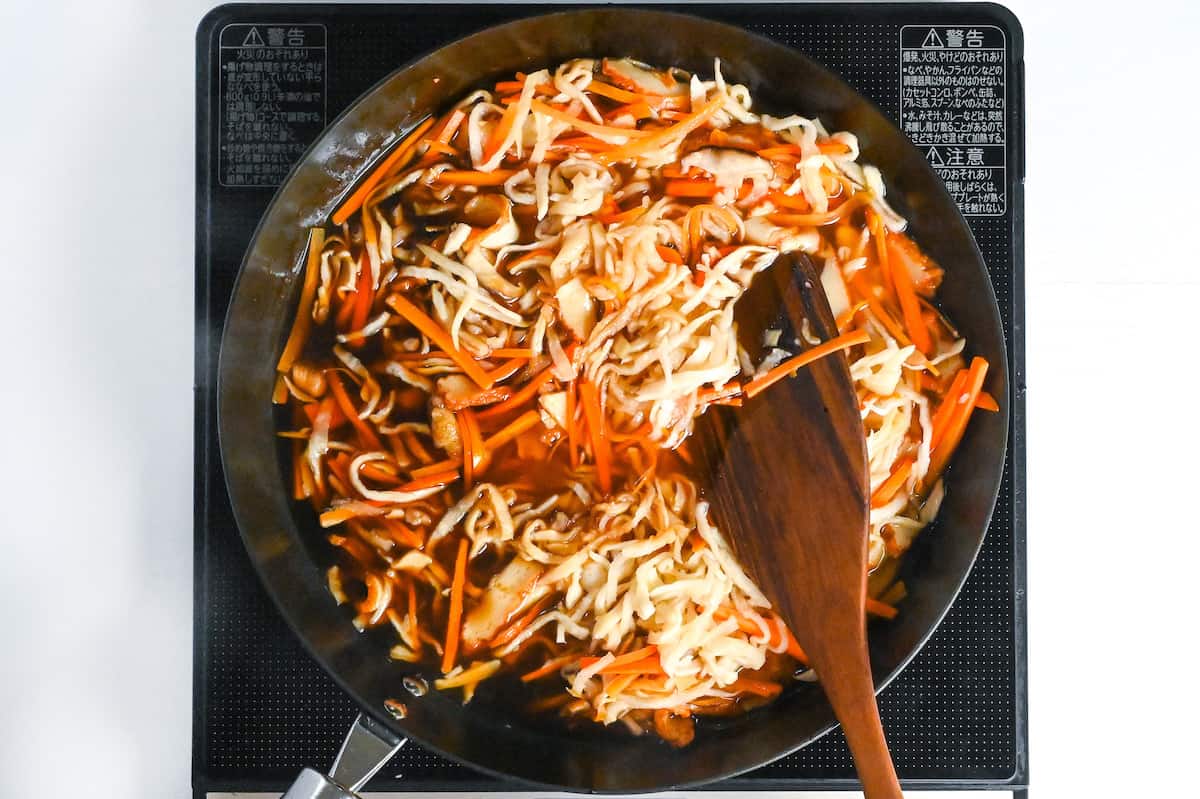
Add the leftover daikon broth from earlier along with soy sauce, mirin and light brown sugar. Mix until evenly distributed and then simmer over a medium heat until the liquid is gone.
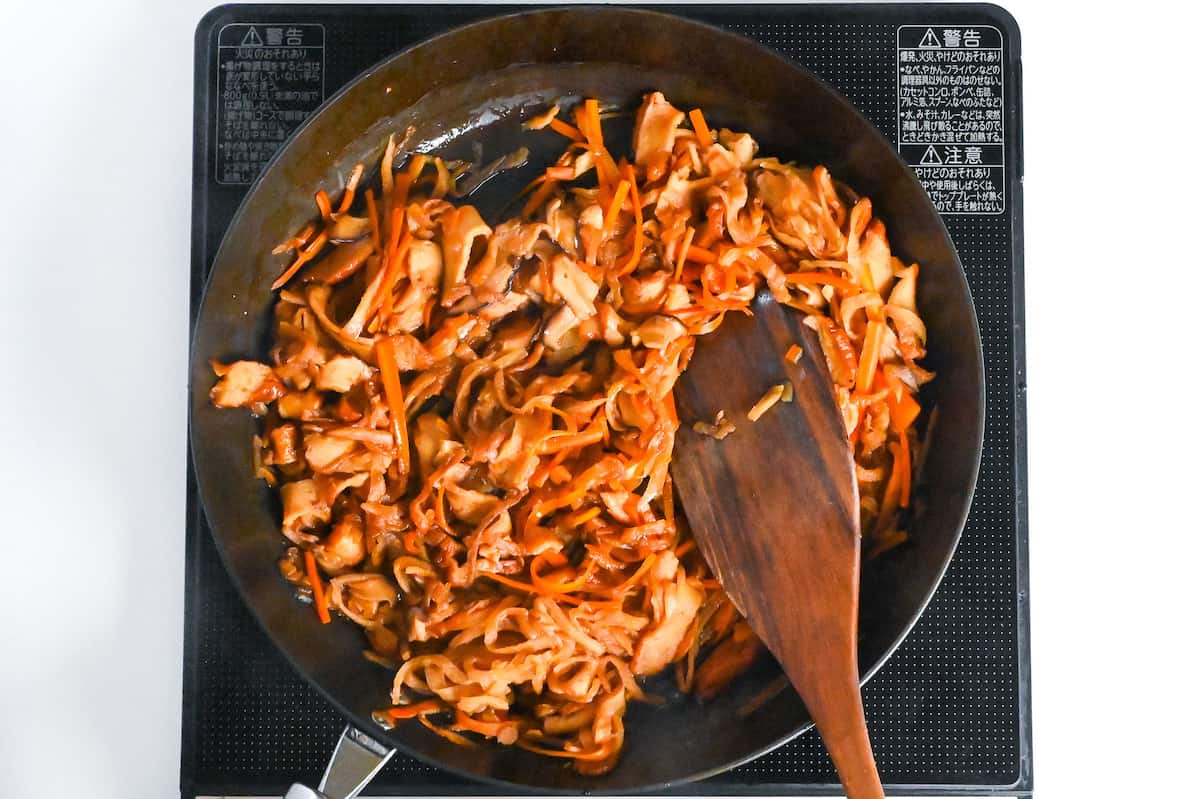
Once the simmering liquid is gone, add the sake and stir fry for 1-2 minutes or until the liquid is gone once more.
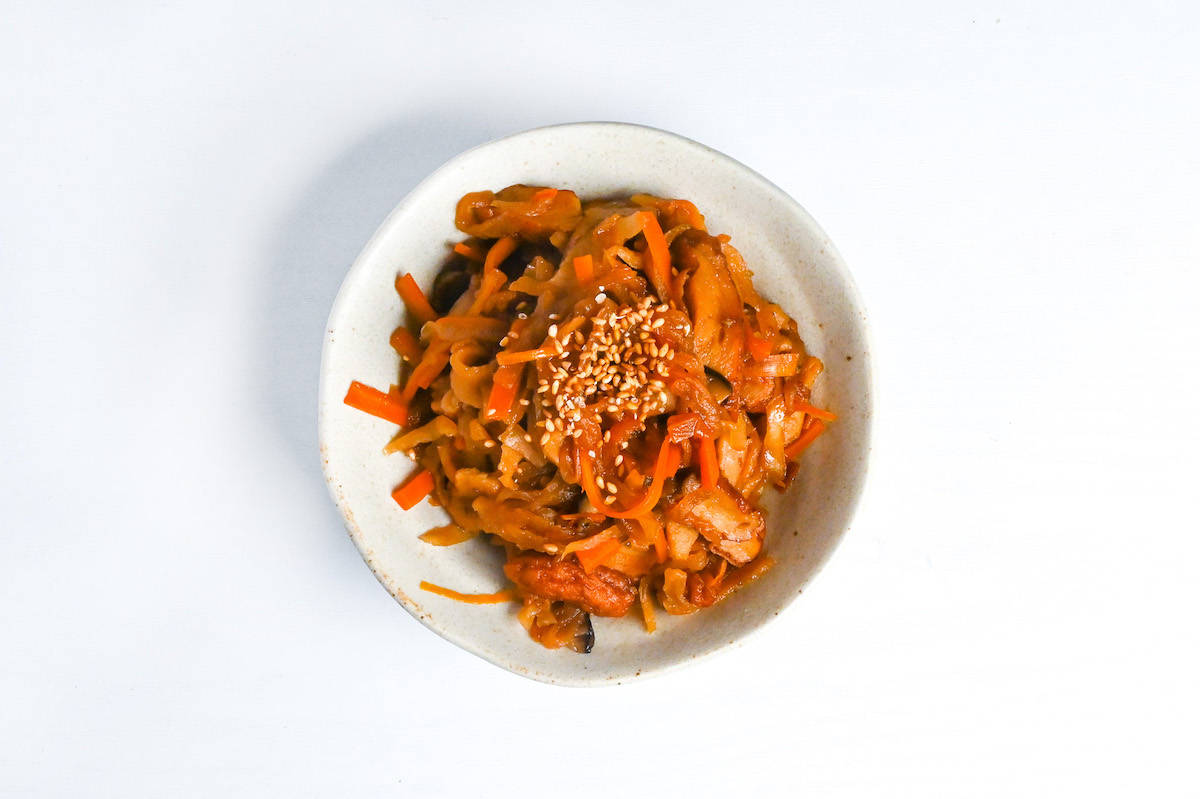
You can leave it to cool or serve it hot depending on your preference. Divide into serving dishes and sprinkle with sesame seeds.
If you leave the simmered kiriboshi daikon to cool down first, the flavors soak deeper into the ingredients and create a better taste overall.
Enjoy!
Jump to Full Recipe MeasurementsHow to Store
Leftover kiriboshi daikon can be kept in an airtight container in the refrigerator for up to 4-5 days.
It can also be frozen for up to 3 weeks. Frozen leftovers should be divided into portions, wrapped with plastic wrap, and then stored in an airtight container like a lunchbox or ziplock bag.
The dish itself can be enjoyed hot or cold so it’s up to you whether you want to reheat it or not. You can reheat it in the microwave or a pan on the stove.
Storage summary
Room temperature – Not recommended.
Refrigerated – 4-5 days.
Frozen – Up to 3 weeks.
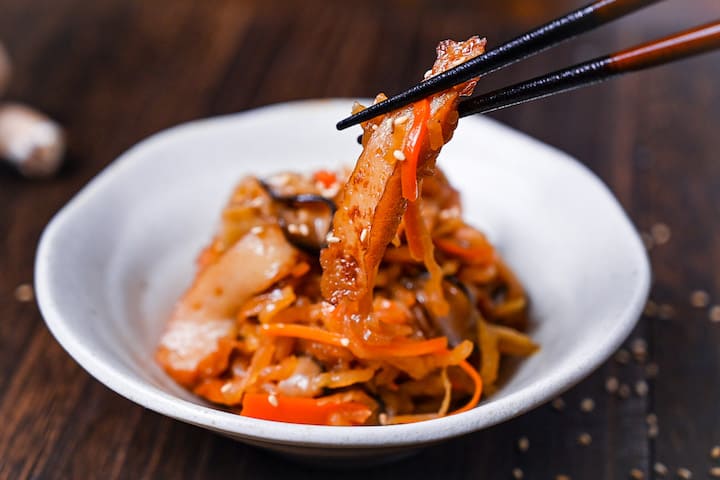
I hope you enjoy this Simmered Kiriboshi Daikon recipe! If you try it out, I’d really appreciate it if you could spare a moment to let me know what you thought by giving a review and star rating in the comments below. It’s also helpful to share any adjustments you made to the recipe with our other readers. Thank you!
More Japanese Side Recipes
- Beef Shigureni (Simmered Wagyu with Ginger and Gobo)
- Japanese Hijiki Seaweed Salad (Hijiki no Nimono)
- Dashimaki Tamago (Japanese Rolled Omelette with Dashi)
- Japanese Simmered Pumpkin (Kabocha no Nimono)
Want more inspiration? Explore my Side Dish Roundup Post for a carefully selected collection of tasty recipe ideas to spark your next meal!
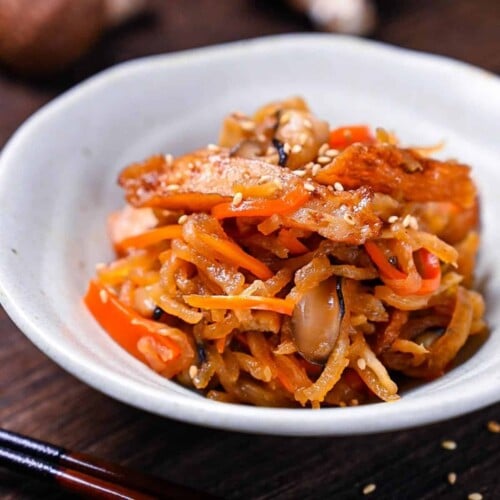
Simmered Kiriboshi Daikon Radish
Ingredients
- 50 g dried shredded daikon (kiriboshi daikon)
- 300 ml cold water for soaking
- 1 tsp toasted sesame oil
- 75 g carrot julienned
- 2 fresh shiitake mushroom julienned
- 100 g satsumaage fishcake for plant-based, sub 2 sheets aburaage, julienned
- 4 tbsp Japanese soy sauce (koikuchi shoyu)
- 4 tbsp mirin
- 15 g light brown sugar
- 1 tsp sake
- toasted white sesame seeds optional garnish
My recommended brands of ingredients and seasonings can be found in my Japanese pantry guide.
Can’t find certain Japanese ingredients? See my substitution guide here.
Instructions
- Place 50 g dried shredded daikon (kiriboshi daikon) in a mixing bowl and cover with cold water. Wash the daikon by rubbing it with your hands and then discard the water. Repeat 3 times in total.

- After the third time, pour 300 ml cold water into the bowl and allow the daikon to soak for 20 minutes.

- Remove the daikon from the water and keep the left over broth for later.

- If the kiriboshi daikon pieces are too long, cut them into thirds.

- Heat a large frying pan on medium and add 1 tsp toasted sesame oil. Once hot, add 75 g carrot, 2 fresh shiitake mushroom and 100 g satsumaage fishcake to the pan and stir fry them for 2-3 minutes.

- Next, add the diakon to the pan and stir fry for another minute.

- Pour in the leftover daikon broth from earlier along with 4 tbsp Japanese soy sauce (koikuchi shoyu), 4 tbsp mirin and 15 g light brown sugar.

- Mix everything together and allow to simmer until the liquid is completely gone.

- Once the liquid is gone, add 1 tsp sake and stir fry for 1-2 minutes.

- Allow to cool (optional), dish up and sprinkle with toasted white sesame seeds.

- Enjoy!
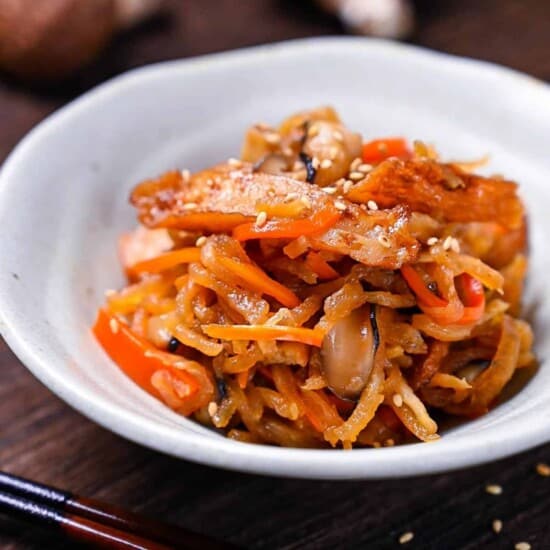


Leave a rating and a comment